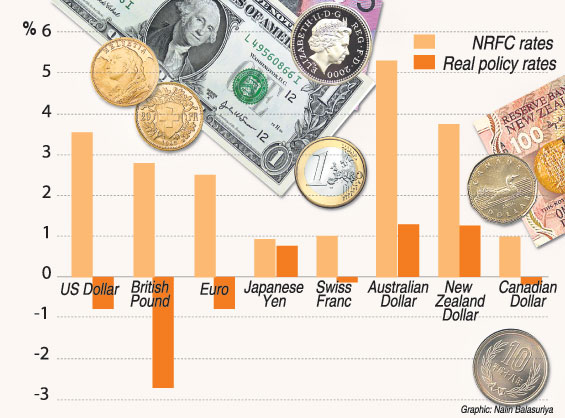Some of the investors most oblivious to the currently unfolding drama across much of the bond universe are NRFC investors in Sri Lanka. Global currencies face significant headwinds, with very few people willing to take a punt on the eventual outcome. Investors, especially migrant workers in the Middle East would do well to understand the new political economy unfolding in developed countries and plan strategies accordingly.
 The bad news is that interest rates across the US, UK, Eurozone and Japan will remain at current historical lows well in to 2011. As a collective, that takes away many investment opportunities for deposit holders of the four most liquid currencies of th world. The Australian dollar offers the best prospects, although its high value is a function of both Chinese demands for resources and the mother of all carry trades (the practice of borrowing in low interest rate countries and investing in high rate countries) from other low interest rate currencies. The bad news is that interest rates across the US, UK, Eurozone and Japan will remain at current historical lows well in to 2011. As a collective, that takes away many investment opportunities for deposit holders of the four most liquid currencies of th world. The Australian dollar offers the best prospects, although its high value is a function of both Chinese demands for resources and the mother of all carry trades (the practice of borrowing in low interest rate countries and investing in high rate countries) from other low interest rate currencies.
The only reason why many investors are holding on to their currencies lie in the foreign exchange demand premium attached to deposits by Sri Lankan banks. Should that disappear (say driven by stronger than expected foreign currency inflows through other means), NRFC investors will wake up one fine day to find their one-year US Dollar deposits yielding less than one percent. Currently, that is the sad reality for many other investors around the world.
The developed world has a depressingly long list of problems with few painless answers. Added to which, global trade imbalances have the US, UK and Germany racing to the bottom in attempting to devalue their respective currencies to promote exports to Asia. Given that all the major currencies now have yields lower than 1% (and negative after adjusting for inflation), the Japanese Yen has become attractive for many institutional investors, driving the value of the Yen higher against most currencies. A decade of low interest rates in Japan don’t seem that out of place now as everyone has joined her in the low interest rate game.
That leaves the Australian dollar as the only high yielding liquid global currency worthy of any attention. On most measures locking in the Aussie at current rates look unattractive given that interest rates are at least 1% below the natural rate and the Reserve Bank of Australia is likely to increase the cash rate through 2011. This expectation is already fully priced into the Aussie currency and I see limited upside over the next year.
The implications for the Sri Lankan rupee as a result of these trends are rather strange. On the one hand, yield hungry global investors will want to pile on to the rupee, thus driving its value higher, prompting the Central Bank to intervene to protectlocal manufacturing. On the other hand, inflation has begun to raise its head again, courtesy of much higher food prices around the world. Higher food prices together with transformative growth are likely to put further pressure for rate hikes locally.
How did the so-called safest and simplest investment decision (to keep your money in a bank account) become this disjointed? For a start, bond markets aren’t too kind to developed countries, with weak growth and demography profiles increasing their debt. The only way rich countries can manage that is to ensure interest rates are very low over a very long period of time. Unfortunately, prudent savers are increasingly being asked to give up rewards for their hard work in order to save reckless borrowers who are leveraged to their neck. Low interest rates are an inducement for you to move money away from bank deposits to more risky (volatile) asset classes.
In this uncertain environment fear is overrun by greed and thus no amount of interest rate cuts seem to get people to bite that carrot. Sooner or later the temptation will become too much and it is likely that investors will drive up asset prices towards another bubble. Debt can be repaid by individuals and governments alike in three ways; sell collateral, increase wages or inflation. Unfortunately for NRFC investors, history seems to point to the last of these as the easiest option most governments choose to take.
The best strategy for NRFC account holders remain the age old wisdom of diversification. Make sure your holdings are spread across at least three currencies, including the currency where your liabilities are most likely to arise. It may also be wise to invest in shorter terms, as inflation may flare up unexpectedly through food and wages, thus making you worse off for locking your money in for longer. The current uncertainty is good reason why investors should never have all their investments in NRFC accounts. A well diversified asset allocation should be the foundation of any investment plan.
(Kajanga is an Investment Specialist based in Sydney, Australia. You can write to him at kajangak@gmail.com).

|

 The bad news is that interest rates across the US, UK, Eurozone and Japan will remain at current historical lows well in to 2011. As a collective, that takes away many investment opportunities for deposit holders of the four most liquid currencies of th world. The Australian dollar offers the best prospects, although its high value is a function of both Chinese demands for resources and the mother of all carry trades (the practice of borrowing in low interest rate countries and investing in high rate countries) from other low interest rate currencies.
The bad news is that interest rates across the US, UK, Eurozone and Japan will remain at current historical lows well in to 2011. As a collective, that takes away many investment opportunities for deposit holders of the four most liquid currencies of th world. The Australian dollar offers the best prospects, although its high value is a function of both Chinese demands for resources and the mother of all carry trades (the practice of borrowing in low interest rate countries and investing in high rate countries) from other low interest rate currencies. 
